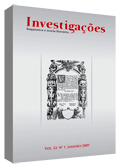História e Psicanálise no discurso ficcional de 'Cavaleiro Andante'
Abstract
A partir da leitura de Cavaleiro Andante, último romance da Tetralogia Lusitana de Almeida Faria, entrevemos, por meio do esteio inconsciente da psicologia, capítulos da História portuguesa mais recente, marcada pelo processo pós-revolucionário por que passou a nação. Procuramos analisar como a obra em questão é signifi cativa para a sondagem do inconsciente, por meio da leitura psicanalítica dos sonhos das personagens. Utilizamos o método psicanalítico de Freud para a análise do material onírico do texto, bem como as refl exões de Hayden White e de Paul Ricoeur a respeito do caráter narrativo das produções historiográfi cas e ficcionais.References
EAGLETON, Terry. A Psicanálise. 2001. In: –.Teoria da literatura: uma introdução. São Paulo: Martins Fontes.
FARIA, Almeida. Cavaleiro andante. 1987. Rio de Janeiro: Nova Fronteira
FREUD, Sigmund. 1969. A interpretação de sonhos. In: –. Obras completas de Sigmund Freud: edição standard brasileira. Tradução sob a direção de Jayme Salomão. Rio de Janeiro: Imago, v.4 e 5.
HERMANN, Jacqueline. 1998. No reino do desejado: a construção do sebastianismo em Portugal. São Paulo: Cia. das Letras.
HUTCHEON, Linda. 1991. Poética do pós-modernismo: história, teoria e ficção. Tradução de Ricardo Cruz. Rio de Janeiro: Imago.
RICOEUR, Paul. 1994. Tempo e narrativa. Tradução de Constança Marcondes César. Campinas: Papirus, 3 v.
SIMÕES, Maria de Lourdes Netto. 1998. As razões do imaginário: comunicar em tempo de revolução 1960-1990: a ficção de Almeida Faria. Salvador: UESC; FCJA.
WHITE, Hayden. 1994. Trópicos do discurso: ensaios sobre a crítica da cultura. Tradução Alípio Correia de Franca Neto et. al. São Paulo: Edusp.
Downloads
Published
How to Cite
Issue
Section
License
Copyright (c) 2009 Tiago Ribeiro dos Santos

This work is licensed under a Creative Commons Attribution 4.0 International License.
Authors who publish with Revista Investigações agree to the following terms:
Authors retain copyright and grant the journal right of first publication with the work simultaneously licensed under the Creative Commons Attribution 4.0 International (CC BY 4.0) license that allows others to share the work with an acknowledgement of the work's authorship and initial publication in this journal.
Authors are able to enter into separate, additional contractual arrangements for the non-exclusive distribution of the journal's published version of the work (e.g., post it to an institutional repository or publish it in a book), with an acknowledgement of its initial publication in this journal.
You are free to:
Share — copy and redistribute the material in any medium or format for any purpose, even commercially.
Adapt — remix, transform, and build upon the material for any purpose, even commercially.
The licensor cannot revoke these freedoms as long as you follow the license terms.
Under the following terms:
Attribution — You must give appropriate credit , provide a link to the license, and indicate if changes were made . You may do so in any reasonable manner, but not in any way that suggests the licensor endorses you or your use.
No additional restrictions — You may not apply legal terms or technological measures that legally restrict others from doing anything the license permits.

